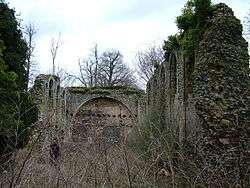Sibton Abbey

Sibton Abbey, an early Cistercian abbey located near Yoxford, Suffolk, was founded about 1150 by William de Chesney, High Sheriff of Norfolk and Suffolk.[1] A sister house of Warden Abbey, near Bedford, Bedfordshire, Sibton Abbey was the only Cistercian abbey in East Anglia.
Sibton Abbey was founded by the normal complement of 13 monks, but by the thirteenth century the numbers of monks and lay brothers had grown, and the Abbey had grown rich, owning lands across southeast England, including estates in Norfolk, Suffolk and on the borders of Cambridgeshire, as well as within 10 parishes of the city of Norwich. From the beginning of the thirteenth century the Abbey also hosted a hospital at its gate dedicated to St. John the Baptist which cared for the sick. Sibton's architectural style was in the austere Cistercian original model.
In the intervening years, Sibton grew rich on proceeds from the wool trade, which built so many grand English churches. Although Suffolk wool wasn't of the finest quality, according to some historians, often stained with tar or grease, it was nevertheless in great demand, particularly in East Anglia, which had many Flemish weavers anxious to convert it into exportable cloth.[2]
At the time of the Dissolution of the Monasteries, Sibton Abbey's annual income was £250, a hefty sum which should have bought the Abbey an additional couple of years before it was dissolved. But the recently appointed Abbot William Flatbury, installed at the insistence of the Duke of Norfolk, apparently was prevailed upon by the Duke and by Thomas Cromwell, 1st Earl of Essex, to hasten the Dissolution, and yield the jewel to those in Royal favour. The engineering of Flatbury's appointment, according to a contemporaneous observer, had been done with the "connivance of Cromwell on purpose to bring about a speedy surrender."[3]
In 1536 the Abbey and its riches were transferred to Thomas Howard, 3rd Duke of Norfolk.[4] The Duke subsequently sold the Abbey again to Thomas Godsalve, who in turn sold it to Thomas Howard, 1st Earl of Suffolk.
In 1610 the Abbey and Manor were sold to John Scrivener, son of Ralph Scrivener, an Ipswich barrister grown rich in the wool trade, and the family built an estate nearby. John Scrivener's brother Matthew was an early Governor of the Virginia Colony, where he drowned in 1609. John Scrivener's sister Elizabeth was married to Harbottle Wingfield of Crowfield Hall, Suffolk, cousin of Edward Maria Wingfield, the first President of the Jamestown Colony. John Scrivener's son, Thomas Scrivener Esq., married Mary Bedingfield, only daughter and heir of William Bedingfield, of Fressingfield, Suffolk and a relation of Sir Henry Bedingfield.[5]
Today Sibton Abbey is a picturesque ruin, largely overgrown, with the refectory and the south wall of the nave still visible. The Abbey and the Manor remain in the hands of the Scrivener heirs, today's Levett-Scrivener family, and the ruins are private.[6] Many of the chartularies of the old Abbey were transferred to the East Suffolk Record Office[7] by J.E. Levett-Scrivener Esq., who also transferred some of the Abbey's early medieval music.[8]

In centuries past, the Levett-Scrivener family sometimes made the ruins available to county historical societies and historians.[9] The Abbey ruins and the adjoining estate are Grade II listed buildings. The buildings are not open to the public.
References
- ↑ William de Chesney, High Sheriff, The English Historical Review, Vol. XXXV, Mandell Creighton, Samuel Rawson Gardiner, Justin Winsor, Longmans, Green & Co., London, 1920
- ↑ The Agrarian History of England and Wales, Joan Thirsk, H. E. Hallam, Stuart Piggott, G. E. Mingay, Edith Holt Whetham, Edward John T. Collins, H. P. R. Finberg, Cambridge University Press, 1967
- ↑ Inward Purity and Outward Splendour: Death and Remembrance in the Deanery of Dunwich, Suffolk, 1370-1547, Judith Middleton-Stewart, Boydell & Brewer, 2001
- ↑ Cistercian Abbeys: Sibton, cistercians.shef.ac.uk
- ↑ A supplement to The Suffolk Traveller (of J. Kirby), or Topographical or Genealogical Collections Concerning that County, Augustine Page (compiler), Joshua Page, Ipswich, 1844
- ↑ Visitation of England and Wales, Vol. III, Joseph Jackson Howard, English College of Arms, Privately Printed, 1893
- ↑ Sibton Abbey Chartularies and Charters, Part Four, Philippa Brown, Boydell Press, 1988
- ↑ Sibton Abbey account book, Saxmundham, Private Collection of J.E. Levett-Scrivener, Digital Image Archive of Medieval Music, diamm.cch.kcl.ac.uk
- ↑ Proceedings, Suffolk Institute of Archaeology and History, Suffolk Institute of Archaeology, Vol. VIII, 1894
External links
Coordinates: 52°16′32″N 1°27′56″E / 52.2756°N 1.4656°E